Visitors Guide to the Acropolis of Athens
The Acropolis and the Parthenon is the image that most people will conjure up when thinking about Athens, and is the highlight of the ancient Greek city and place that virtually every traveller will visit. The ancient citadel not only reflects the pinnacle of Ancient Greece and period of Classical Greek architecture and art but also serves as a testament to the cultural and intellectual achievements of the Athenian city-state and Greek civilization in general.

The Acropolis of Athens is the rocky hill, which literally translates as meaning the “highest point of the city” or the "high city" – with polis being the word for city and agro being the word for high. Ancient Athens wasn’t the only Greek city with an Acropolis, but it is certainly the most famous one.
The Parthenon is the dominating Doric temple, built around the mid-5th century that stands proudly on the top of the fortified citadel along with the Greek flag, and is dedicated to the goddess Athena whom the Athenians considered the patron of the city.
This stunning structure is something you need to see with your own eyes to realize the magnitude and craft that went into its construction by Pericles in the 5th Century B.C., who devised his plan to reconstruct temples on the Acropolis after they were destroyed in 480 B.C. by the Persians.
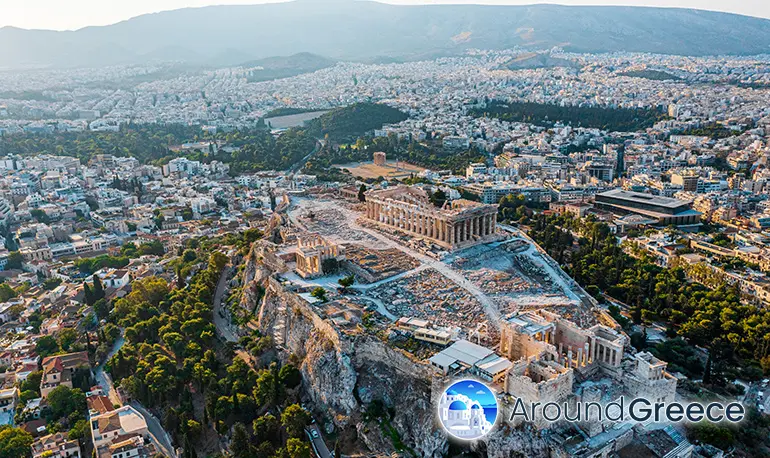
The Acropolis and Parthenon temple, which is an architectural masterpiece and was adorned by sculptures of gods and deities, should be on the “must see list” of every visitor to Athens and should one of the top things to do. The archaeological site, which is the essence of classical Greece, along with the museum, is located right in the center of the historic city and is a very easy place to reach.
Historic Overview
The Acropolis of Athens is an enduring symbol of Greece and a testament to the heights of classical civilization. Its history is rich and spans thousands of years.
The roots of the Acropolis trace back to the Mycenaean period when the city known as Kekropia after the Athenian king. During that time it served as a fortress atop the high rocky hill and has been inhabited since then. Later, in the subsequent Archaic period, the focus shifted to religious activities. Temples such as Athena Polias and dedicatory structures began to replace the earlier military fortifications and walls that were built around the summit.

The Golden Age of Pericles in the 5th century B.C. saw the influential Athenian statesman, envisioning a monumental Acropolis that would showcase the city-state's cultural and political achievements. The Parthenon, dedicated to the goddess Athena, and the Propylaea, the grand entrance, exemplify the architectural brilliance of this great era and the Athenians.
However, war and destruction were not far away, and the Persians, led by Xerxes (son of King Darius), sacked the Acropolis in 480 B.C. during the second Persian invasion of Greece. Structures including the temple of Athena Polias were razed to the ground by the end of the war. After the Persian Wars, a vast reconstruction project was initiated. The new buildings, designed by eminent architects, showcased innovative architectural and artistic techniques.
During the Hellenistic period, the Erechtheion, a temple dedicated to both Athena and Poseidon, was erected. Its Porch of the Caryatids, with sculpted female figures as columns, is iconic. During the Roman era, further construction followed and modifications and additions were made, reflecting the evolving cultural and religious landscape.
During the Byzantine period, the Parthenon was transformed into a church devoted to the Virgin Mary. New religious structures, like the Church of the Holy Apostles, were added. When the Ottomans ruled, the Parthenon became a mosque. The Acropolis served various purposes, including a garrison and a powder magazine, which led to the catastrophic explosion in 1687.

In the 19th century, Lord Elgin removed a significant portion of the sculptures (now known as the Elgin Marbles), which are now housed in the British Museum in London. The same century witnessed a resurgence of interest in Greek antiquity. Philhellenes, inspired by the ideals of ancient Greece, advocated for Greek independence.
Systematic archaeological excavations that were initiated by local authorities uncovered layers of history, revealing streets, sanctuaries, and a wealth of artifacts. The Acropolis Restoration Project, launched in the 1970s, faced challenges such as preserving the integrity of antique materials that were in use thousands of years ago, while incorporating modern technology.

The Acropolis Museum, designed to display the original sculptures and artifacts in a context resembling their original locations, opened in 2009. It is one of the most impressive museums in the world and one that every visitor to the capital should visit and enjoy.
The Acropolis stands as a living testament to the ebb and flow of history from the Mycenaean period up to the present day, witnessing the rise and fall of ancient gods and empires, cultural transformations, and the enduring legacy of ancient Greece. Its journey from a fortified hill to a symbol of classical splendor reflects the resilience and timeless significance of this archaeological marvel.
Acropolis Tour Highlights
Nestled atop the rocky prominence of Athens, the Acropolis beckons as the undisputed crown jewel of Greece's archaeological wonders. A sacred rock, cloaked in myths and adorned with architectural marvels, the Acropolis isn't merely a collection of ruins or ancient buildings; it's a portal to a bygone era that shaped the very essence of Western civilization.
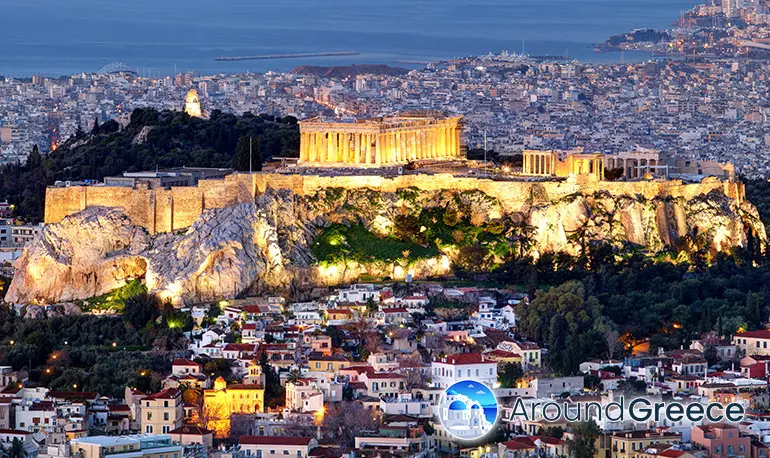
Walk the worn steps where countless sandals and footsteps of philosophers, warriors, and ordinary Athenian citizens have left their indelible mark. The Acropolis has weathered the tempests of time, from the glory of the Golden Age to the ravages of war, each layer of history etched into its ruined stones.
A visit here is more than a tour; it's a pilgrimage through epochs, an immersion in the very fabric of democracy, philosophy and art. It's an odyssey into the heart of Hellenic civilization, leaving an indelible imprint on those fortunate enough to heed its call.
Below we will take a look at some of the highlights of this archaeological wonder.
Parthenon
The Parthenon is the most iconic structure on the Acropolis and is well known throughout the world. Dedicated to the goddess Athena, it's an exemplary display of Doric architecture with its impressive columns and intricate friezes. Originally adorned with colossal statues and vibrant colors, it represented the peak of classical Greek artistry. It was 69.5 meters long and 30.9 meters in width.
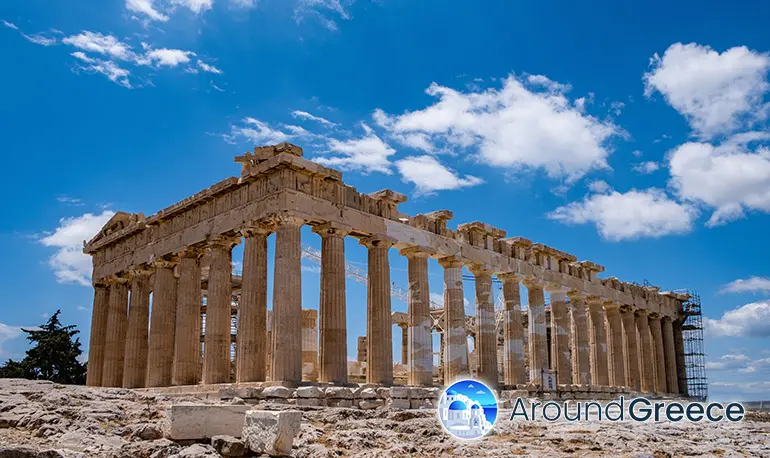
Propylaea
The Propylaea serves as the monumental entrance to the summit, and was designed by the architect Mnesicles and built with Pentelic marble. It features a central hall with a large central gateway and two wings, showcasing Doric and Ionic architectural elements. The impressive structure served as both an entrance and a ceremonial gateway to the sacred precinct.
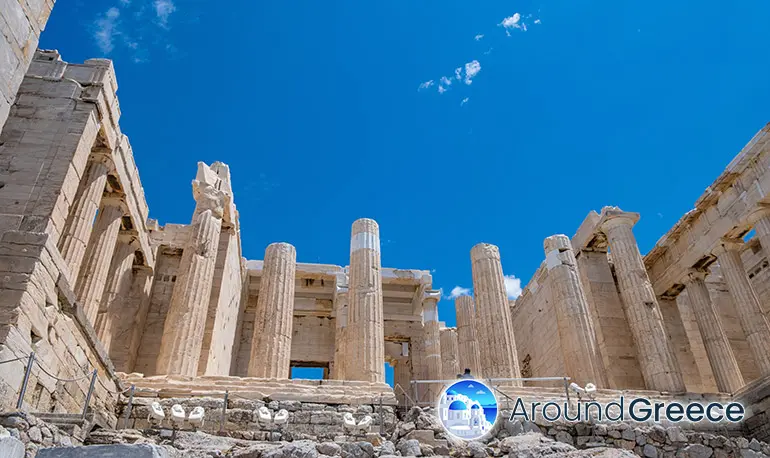
Erechtheion
The Erechtheion, located on the north side, is a unique temple devoted to Athena and Poseidon. The Porch of the Maidens, with its Caryatid statues, is a highlight of this unique masterpiece with each maiden carrying the weight of the temple's roof on her head. The temple's irregular plan accommodates the various cults and myths associated with the site.
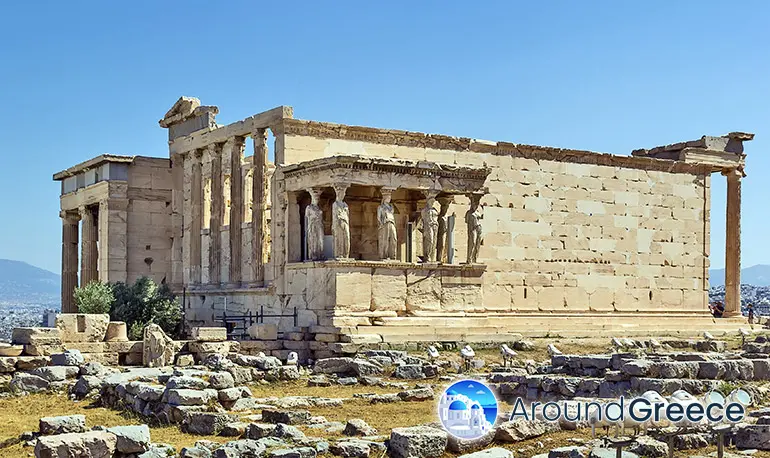
Temple of Athena Nike
The Temple of Athena Nike is a small temple, situated on the southwest corner of the Acropolis, is dedicated to Athena Nike, the goddess of victory. The temple's name translates to "Victorious Athena," and it served as a symbolic representation of Athens' triumphs in war.

Odeon of Herodes Atticus
The Odeon of Herodes Atticus is a Roman-era amphitheater, with the venue still being used for concerts and performances today. The Odeon, with its breathtaking view of Athens, reflects the grandeur of public entertainment in the Roman period.
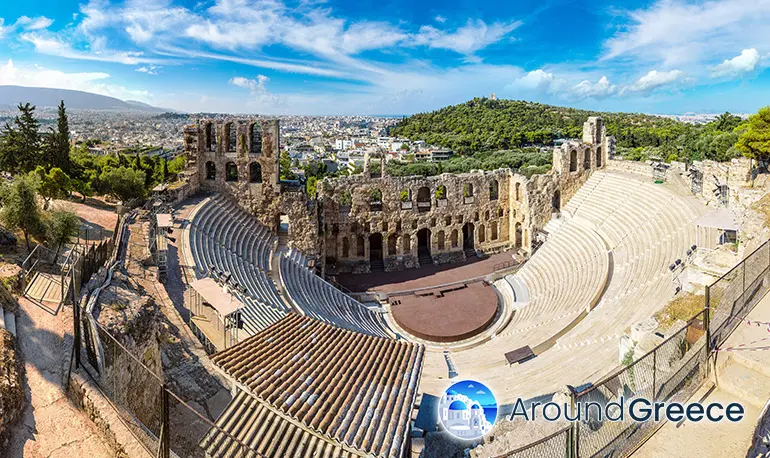
Dionysus Theatre
The Dionysus Theatre on the natural setting of the southern slope, is one of the oldest theaters in the world, hosting dramas and festivals. It provides insight into the cultural and religious significance of theatrical performances in ancient Athens.
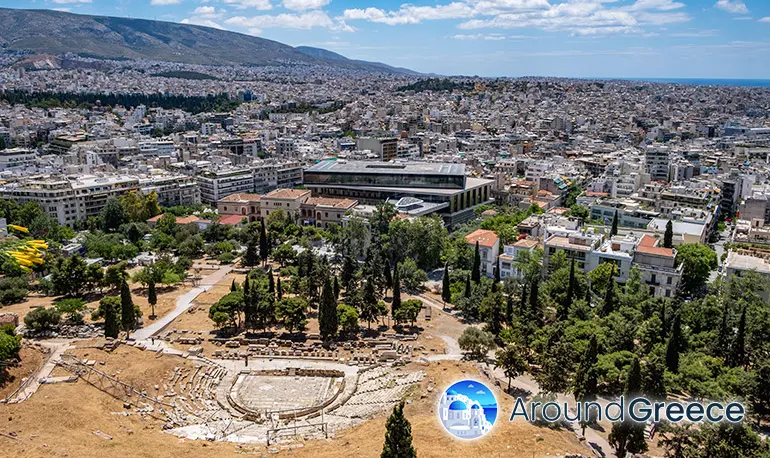
How to Get There
There are a number of Metro stations that you can arrive at, and from their you will take a short walk to the entrance, which is located on the west side of the Acropolis, a short distance from the Areopagus, also known as the Hill of Ares.
The nearest Metro station is “Acropolis”, and upon exiting the station you will follow the path next to the south slope and head westwards. The other stations you can use are Monastirki and Thissio, and from these you will either pass through or around the Agora and the district of Plaka, and then head towards to the entrance.
If you are travelling from the Athens Airport, then you will be able to take the Metro which has a connection from with the Syntagma station in the centre of the city. From there you can switch trains and take the short journey to Monastriki station. The total travel time from the airport Metro station to Monastriki takes around 45 minutes. The expansion of the Athens Metro has made travelling around the city quicker and easier, and is the best form of transportation for visitors.

Athens Acropolis Tickets
You can purchase your tickets to the Acropolis from the ticket office that are located opposite the entrance. There are two types of ticket you can purchase, the single entry ticket, which gives you access to the main site and the North and South slopes. This ticket costs €20, while there is a reduced rate of €10, which is for Greek and EU citizens over the age of 65, students and parents escorting their children on school trips.
There is also the Multi Ticket which is available for €30 (€15 reduced rate) which also allows access to other archaeological monuments in Athens include the Ancient Agora archaeological site and museum, Kerameikos, the Roman Agora and Hadrian’s Library. Although this multi ticket is valid for 5 days, it should be more than enough time for you to visit these unique sights and attractions in the city.
Free Admission
There are also several days in the year where there is free admission to the historic site.
- 6th March (in memory of Melina Mercouri)
- 18th April (International Monuments Day)
- 18th May (International Museums Day)
- The last weekend in September (European Heritage Days)
- 28th October
- Every first Sunday from 1st November to 31st March
Athens Acropolis Opening Hours
The monument is open to visitors from 08:00 through to 19:30 during the summer and to 17:00 during the winter. If you are visiting during the summer months, then it would best to avoid the hours between 11:00 to 13:00 when the sun will be at its strongest, as there is very little shade.
Summer Opening Times:
8:00- 19:30 - Last entrance is at 19:00
Winter Opening Times:
8:00- 17:00 - Last entrance is at 16:30
During the months of September and October, the closing time is gradually reduced due to the shortening of the day. The closing times are as follows:
- 1st to 15th September 08:00 - 19:30 - Last entrance at 19:00
- 16th to 30th September 08:00 - 19:00 - Last entrance at 18:30
- 1st to 15th October 08:00 - 18:30 - Last entranceat 18:00
- 16th to 30th October 08:00 - 18:00 - Last entrance at 17:30
Dates the Acropolis is Closed
There are a number of days throughout the year when the ancient Greek site will be closed.
- 1 January
- 25 March
- 1 May
- Easter Sunday
- 25 December
- 26 December
Exiting the Monument
Once most visitors time at the top of the Acropolis comes to an end, they usually make their way north turning right at the exit, heading to the well known Plaka and Monastiriki districts in the historic centre of the city. However, it is the South Side that should definitely be visited when you make your way down, as it is here where you will find several more archaeological sites and ruins of great interest from the ancient world.
It was in classical times that the south side of the Acropolis played a huge role in the spiritual, artistic and religious activity of the Greek city. The Ancient Agora was the democratic centre of Athens during these times, whilst it was on the southern slopes that tragedy was born.
One the south wall, you will find two very important theatres, which date back to the 6th Century B.C. These are the Theatre of Dionysos and the Odeon of Herodes Atticus, which have been at the intellectual heart of Athens since those days.

Located just across from the Theatre of Dionysos is the modern Acropolis Museum. Make sure you put aside some time later on to pay a visit to this stunning museum, and see all the beautiful exhibits and displays featuring priceless artifacts and findings from ancient Greece including the headless statue of Athena Parthenos that was discovered in 1860. A visit here after descending from the summit is the perfect way to end to your historic Athens experience.
Map of Acropolis
Below you will find a map which shows the location in Athens city center. Click on the map image below to load the Google map.
Athens hotels near the Acropolis
The area around the citadel is a truly unique part of Athens and there is a large choice of accommodation and hotels where you can find stay. The allure of staying at a hotel near to the Acropolis archaeological site is appealing to many people as it will be within very easy walking distance, and also gives you the best chance to see it during the night, when it is beautifully lit up.
You'll be able to find various types of accommodation in the area including hotels in Plaka and hotels in Monastiraki, both of which are literally right under the monument. If you are lucky enough, you might also find that your room has a great view of the Acropolis and Parthenon. If you don't mind a short walk from your hotel to the site, then you should also consider staying in or close to Syntagma, Psiri or Koukaki .
Discover the Historic Acropolis
Acropolis History
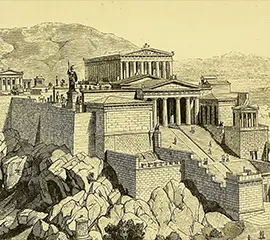
The history of the sacred rock is a unique story that goes back over thousands of years. Read the history of this unique part of Athens that shaped Western Civilization and the rest ..... Read More
The Parthenon

The Parthenon is the jewel on the crown of the Acropolis, and is the stunning temple dedicated to Athena which is famous throughout the world, as well as being the best symbol of ..... Read More
The Erechtheion

The Erechtheion is the Ionic temple to the north of the Parthenon that was a rather unusual structure with a complicated internal layout compared to other temples ..... Read More
Temple of Athena Nike

This small temple at the front of the Acropolis was made entirely out of marble and is the earliest Ionic temple on the site, and it was dedicated to the goddess Athena Nike ..... Read More
The Propylaea

The Propylaea was the grand entrance of the Acropolis and Parthenon, and was a stunning piece of architecture through which all visitors to the site will pass through ..... Read More
Other Structures

There were also many other structures and important buildings on the top of the Acropolis in addition to the Parthenon though only ruins of these remain today ..... Read More
Theatre of Dionysos

The impressive Theatre of Dioysos located on the south slope of the ancient walls, and classical works by Sophocles, Euripides and Aeschylus were performed here ..... Read More
Odeon of Herodes Atticus

Located to the west of the Theatre of Dionysos is the Odeon of Herodes Atticus, a stunning theatre that was built in 160 A.D. and which still has performances today ..... Read More
Thrasyllos Monuments

There is very little that remains today of the Choregic Monument of Thrasyllos, which you will see on the south wall of the site above the old Theatre of Dionysos ..... Read More
Stoa of Eumenes

The Stoa of Eumenes, a gift from King of Pergamon Eumenes II, is a connection between the Odeon of Herodes Atticus and the Theatre of Dioynsos at the foot of the citadel ..... Read More
Sanctuary of Asclepius

Situated next to the Theatre of Dionysos on the south slope of the sacred rock is the Sanctuary of Asclepius built by Eumenes II, an impressive set of ruins dedicated to Asclepius, the God of Medicine who ..... Read More
